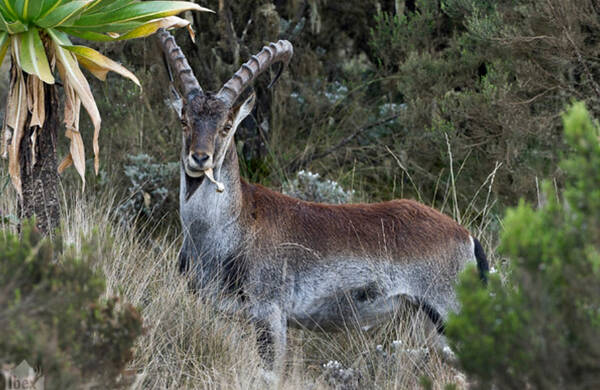Capra walie
IUCN
LCBasic Information
Scientific classification
- name:Capra walie
- Scientific Name:Capra walie
- Outline:Ungulata
- Family:Artiodactyla Bovidae Capra
Vital signs
- length:175-196cm
- Weight:80-125kg
- lifetime:About 15 years
Feature
Both sexes have horns, and the front surface of the male horns has very obvious ridges.
Distribution and Habitat
Found only in the northern mountainous regions of Ethiopia. Almost all remaining species live in the escarpment 25 km north of the Simien National Park. The Simien National Park (SMNPT) is the southernmost point of the range of the genus Capra in the world and the only place where the Walia Ibex occurs.
The Walia Ibex is found in the highlands of the Simien Mountains, between 2,300 -4,000 m above sea level, in a narrow and restricted habitat. The main distribution range is steep, rocky terrain and heterogeneous slopes, no more than 5 km from east to west along the escarpment, with a limited range of habitat between north and south.
Appearance
The Varian Ibex, like other members of the genus Capra, is sexually dimorphic in many aspects of its appearance. The total weight of an adult female is about 80 kg, about 50-60% of the weight of a male, who can weigh up to 125 kg. Both sexes have horns, which are thin and slightly arched in females. However, the males have larger semicircular horns that can reach 110 cm in length. The front surface of the male horns has very distinct ridges (mature males may have more than ten of these ridges).
Both sexes have black and white markings on the legs, and the underparts are off-white. The dorsal area is chestnut brown, darker in males. In the wild, females are lighter in color. Males have black whiskers on their chins, and older males also have very dark chests and black bands along their flanks.
Perhaps as an adaptation to the mountainous environment, the Varian Ibex's hooves have sharp edges and concave undersides that act as "suction cups" to improve their grip.
Details
The Walia Ibex (Capra walie) has no subspecies. Walia Ibex are active or feeding only in the early morning and late evening. They usually become lethargic around midday and tend to hide under dense bushes, away from the strong midday sun and any nearby predators.

As a "generalized herbivore", the Varian Ibex is both a herbivore and a grazer. In fact, their diet includes a wide variety of grasses and shrubs. Although herbivory accounts for a larger part of their diet, the species spends most of its time foraging in dense undergrowth. Food includes grasses, twigs, shrubs, leaves, lianas, and lichens.
The typical mating system of the Varian Ibex is polygamous, with dominant males producing a disproportionate number of offspring during the breeding season. These males, due to their large size and combat experience, are able to monopolize females by obtaining exclusive mate-seeking rights that overlap the female home ranges.

The Varian Ibex differs from other Capra species in that it can breed all year round. This is probably because the lack of temperature seasonality in the Simien Mountains, which is located in a tropical area, has no environmental cost to individuals that breed year-round. Nevertheless, the usual mating season for the Varian Ibex is from February to April. Peak sexual activity between males and females is observed between March and June, overlapping with a short estrus season. The species reaches sexual maturity at one year old, however, both sexes continue to grow, with age related to body size.
The Varian Ibex is assessed as Vulnerable (VU) under the "IUCN Red List Category and Criteria D1+2" due to its small population size, which is much smaller than 1,000 individuals but exceeds 250 mature individuals. The weakening of current protections could lead to a renewed influx of humans, habitat destruction and poaching. There is also a risk of disease transmission from livestock (e.g., foot-and-mouth disease, peste des petits ruminants or contagious caprine pleuropneumonia), or simply an outbreak of unknown origin (e.g., mange). Both threats could quickly push the Varian Ibex to "Critically Endangered" or "Extinct".
Listed in the IUCN Red List of Threatened Species in 2020 ver3.1 - Vulnerable (VU).
Protect wild animals and eliminate game.
Maintaining ecological balance is everyone's responsibility!








